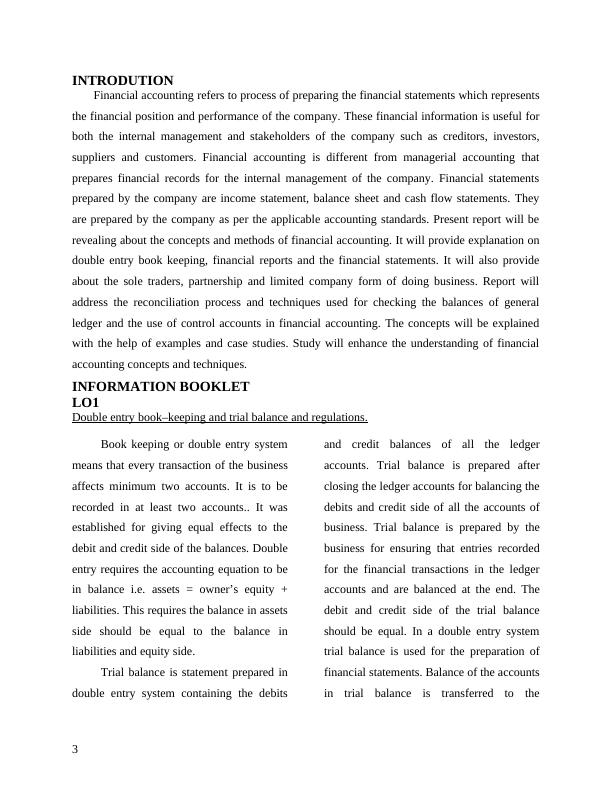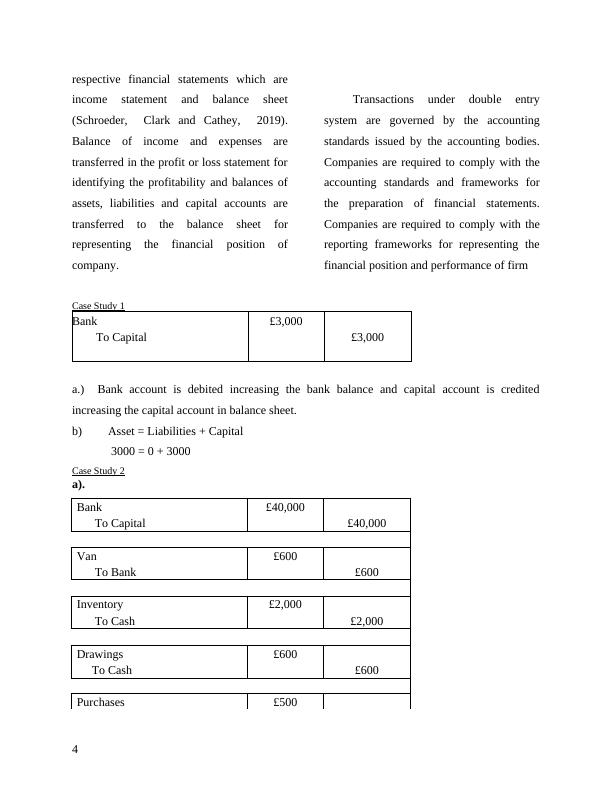Financial Accounting
20 Pages4294 Words65 Views
Added on 2023-01-12
Financial Accounting
Added on 2023-01-12
ShareRelated Documents
FINANCIAL ACCOUNTING

TABLE OF CONTENTS
INTRODUTION .............................................................................................................................3
INFORMATION BOOKLET..........................................................................................................3
LO1..................................................................................................................................................3
Double entry book–keeping and trial balance and regulations....................................................3
Case Study 1................................................................................................................................4
Case Study 2................................................................................................................................4
Case Study 3................................................................................................................................5
Case Study 4................................................................................................................................5
Case Study 5................................................................................................................................8
Difference between the financial reports and financial statements. ...........................................9
LO2................................................................................................................................................10
Explanation of the accounts for sole trader, partnership and limited company and their
differences..................................................................................................................................10
Final accounts of sole trader, partnership and company............................................................11
LO3................................................................................................................................................14
Explanation of the reconciliation process and tools & techniques used for checking general
ledger accounts. Explanation on variances and importance of the correctly entered figures....14
Bank Reconciliation Statement..................................................................................................15
LO4................................................................................................................................................16
Explanation of the control accounts and their use in financial accounting................................16
Description of process for reconciling control accounts and need to reconcile the accounts....17
Explanation on purpose of suspense accounts and their difference from the control accounts.18
Control Account.........................................................................................................................19
CONCLUSION .............................................................................................................................20
REFERENCES..............................................................................................................................21
INTRODUTION .............................................................................................................................3
INFORMATION BOOKLET..........................................................................................................3
LO1..................................................................................................................................................3
Double entry book–keeping and trial balance and regulations....................................................3
Case Study 1................................................................................................................................4
Case Study 2................................................................................................................................4
Case Study 3................................................................................................................................5
Case Study 4................................................................................................................................5
Case Study 5................................................................................................................................8
Difference between the financial reports and financial statements. ...........................................9
LO2................................................................................................................................................10
Explanation of the accounts for sole trader, partnership and limited company and their
differences..................................................................................................................................10
Final accounts of sole trader, partnership and company............................................................11
LO3................................................................................................................................................14
Explanation of the reconciliation process and tools & techniques used for checking general
ledger accounts. Explanation on variances and importance of the correctly entered figures....14
Bank Reconciliation Statement..................................................................................................15
LO4................................................................................................................................................16
Explanation of the control accounts and their use in financial accounting................................16
Description of process for reconciling control accounts and need to reconcile the accounts....17
Explanation on purpose of suspense accounts and their difference from the control accounts.18
Control Account.........................................................................................................................19
CONCLUSION .............................................................................................................................20
REFERENCES..............................................................................................................................21

INTRODUTION
Financial accounting refers to process of preparing the financial statements which represents
the financial position and performance of the company. These financial information is useful for
both the internal management and stakeholders of the company such as creditors, investors,
suppliers and customers. Financial accounting is different from managerial accounting that
prepares financial records for the internal management of the company. Financial statements
prepared by the company are income statement, balance sheet and cash flow statements. They
are prepared by the company as per the applicable accounting standards. Present report will be
revealing about the concepts and methods of financial accounting. It will provide explanation on
double entry book keeping, financial reports and the financial statements. It will also provide
about the sole traders, partnership and limited company form of doing business. Report will
address the reconciliation process and techniques used for checking the balances of general
ledger and the use of control accounts in financial accounting. The concepts will be explained
with the help of examples and case studies. Study will enhance the understanding of financial
accounting concepts and techniques.
INFORMATION BOOKLET
LO1
Double entry book–keeping and trial balance and regulations.
Book keeping or double entry system
means that every transaction of the business
affects minimum two accounts. It is to be
recorded in at least two accounts.. It was
established for giving equal effects to the
debit and credit side of the balances. Double
entry requires the accounting equation to be
in balance i.e. assets = owner’s equity +
liabilities. This requires the balance in assets
side should be equal to the balance in
liabilities and equity side.
Trial balance is statement prepared in
double entry system containing the debits
and credit balances of all the ledger
accounts. Trial balance is prepared after
closing the ledger accounts for balancing the
debits and credit side of all the accounts of
business. Trial balance is prepared by the
business for ensuring that entries recorded
for the financial transactions in the ledger
accounts and are balanced at the end. The
debit and credit side of the trial balance
should be equal. In a double entry system
trial balance is used for the preparation of
financial statements. Balance of the accounts
in trial balance is transferred to the
3
Financial accounting refers to process of preparing the financial statements which represents
the financial position and performance of the company. These financial information is useful for
both the internal management and stakeholders of the company such as creditors, investors,
suppliers and customers. Financial accounting is different from managerial accounting that
prepares financial records for the internal management of the company. Financial statements
prepared by the company are income statement, balance sheet and cash flow statements. They
are prepared by the company as per the applicable accounting standards. Present report will be
revealing about the concepts and methods of financial accounting. It will provide explanation on
double entry book keeping, financial reports and the financial statements. It will also provide
about the sole traders, partnership and limited company form of doing business. Report will
address the reconciliation process and techniques used for checking the balances of general
ledger and the use of control accounts in financial accounting. The concepts will be explained
with the help of examples and case studies. Study will enhance the understanding of financial
accounting concepts and techniques.
INFORMATION BOOKLET
LO1
Double entry book–keeping and trial balance and regulations.
Book keeping or double entry system
means that every transaction of the business
affects minimum two accounts. It is to be
recorded in at least two accounts.. It was
established for giving equal effects to the
debit and credit side of the balances. Double
entry requires the accounting equation to be
in balance i.e. assets = owner’s equity +
liabilities. This requires the balance in assets
side should be equal to the balance in
liabilities and equity side.
Trial balance is statement prepared in
double entry system containing the debits
and credit balances of all the ledger
accounts. Trial balance is prepared after
closing the ledger accounts for balancing the
debits and credit side of all the accounts of
business. Trial balance is prepared by the
business for ensuring that entries recorded
for the financial transactions in the ledger
accounts and are balanced at the end. The
debit and credit side of the trial balance
should be equal. In a double entry system
trial balance is used for the preparation of
financial statements. Balance of the accounts
in trial balance is transferred to the
3

respective financial statements which are
income statement and balance sheet
(Schroeder, Clark and Cathey, 2019).
Balance of income and expenses are
transferred in the profit or loss statement for
identifying the profitability and balances of
assets, liabilities and capital accounts are
transferred to the balance sheet for
representing the financial position of
company.
Transactions under double entry
system are governed by the accounting
standards issued by the accounting bodies.
Companies are required to comply with the
accounting standards and frameworks for
the preparation of financial statements.
Companies are required to comply with the
reporting frameworks for representing the
financial position and performance of firm
Case Study 1
Bank £3,000
To Capital £3,000
a.) Bank account is debited increasing the bank balance and capital account is credited
increasing the capital account in balance sheet.
b) Asset = Liabilities + Capital
3000 = 0 + 3000
Case Study 2
a).
Bank £40,000
To Capital £40,000
Van £600
To Bank £600
Inventory £2,000
To Cash £2,000
Drawings £600
To Cash £600
Purchases £500
4
income statement and balance sheet
(Schroeder, Clark and Cathey, 2019).
Balance of income and expenses are
transferred in the profit or loss statement for
identifying the profitability and balances of
assets, liabilities and capital accounts are
transferred to the balance sheet for
representing the financial position of
company.
Transactions under double entry
system are governed by the accounting
standards issued by the accounting bodies.
Companies are required to comply with the
accounting standards and frameworks for
the preparation of financial statements.
Companies are required to comply with the
reporting frameworks for representing the
financial position and performance of firm
Case Study 1
Bank £3,000
To Capital £3,000
a.) Bank account is debited increasing the bank balance and capital account is credited
increasing the capital account in balance sheet.
b) Asset = Liabilities + Capital
3000 = 0 + 3000
Case Study 2
a).
Bank £40,000
To Capital £40,000
Van £600
To Bank £600
Inventory £2,000
To Cash £2,000
Drawings £600
To Cash £600
Purchases £500
4

End of preview
Want to access all the pages? Upload your documents or become a member.
Related Documents
Financial Accounting: Concepts and Techniqueslg...
|21
|4301
|64
Financial Accounting INTRODUCTION 1 TASK 11 Question 1 2 7 TASK 29 Question 1 2 7 CONCLUSION 11 REFERENCES 12 INTRODUCTIONlg...
|14
|1243
|343
Level 5 Higher National diploma: Unit 10 - Financial Accountinglg...
|37
|8455
|8
FINANCIAL ACCOUNTING PRINCIPLE INTROUCTION 1 PART A1 Business Reportlg...
|36
|9395
|326
Financial Accounting: Record Transactions and Prepare Final Accountslg...
|33
|7917
|68
Assignment Front Sheet Learner Name Learner Student I.D. Assessor Name Navroop Sandhu 1017470 Mr. LAMlg...
|36
|9707
|279
